How Much Wood, Indeed, Chuck?
London: Gateway to Slough
Main -- House -- History -- Cornwall -- Getting There -- On the Road -- The Roads -- London -- The Far West -- Boring Details -- Updates
London, London, London. What is there to say? There are books upon books of things to see, books upon books of the history of the town (you wanna read? Ackroyd's "London: a Biography" is nice, if a bit much for a first-time visitor), and there's not enough time in a life to follow all those threads. But if you're visiting, it is still possible to get a sense of the layers of history in the city. Let's approach this chronologically.
In the Beginning There Was...
Well, nobody knows how London began. It's one of those "what was there before there was anything" kind of questions. Precious little survives which is pre-Roman, but it's hard to believe that the people of all the prehistoric ages from the Stone Age through the Iron Age didn't use this site. Whatever they did do here, however, has been written-over many times since.
The Romans: LondiniumWe do know that the Romans were here. They named the city "Londinium," and you can even see some of their handiwork. They built a city, and after the queen of the Iceni, Boudicca, led an army through and burned it down (Boudicca was in the right; a very Bryn Mawr woman before that meant anything, and a badass), they realized that the city needed defenses. The Romans built a wall around the city, bits of which (with later additions) can be seen to this day; a good section is just outside the Tower Hill tube station, where there is also a Roman gatehouse you can view in a pit between the station and the Tower. Inside the Tower, a bit of Roman wall has been excavated, too, and if you visit the Museum of London you can pick up details on the Wall Walk, which takes you past all of the currently-visible bits of the wall (and you can see a bit of it just outside the museum, too--see right). Roman artifacts are on display at the Museum of London, and the foundations of a Roman amphitheater are open to public viewing in the basement of the Guildhall Art Museum. | 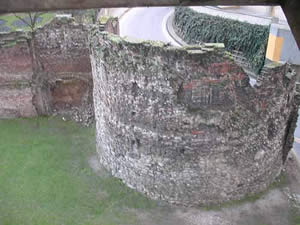 Bits of the Roman Wall |
The Dark Ages:
Well, then the archaeology that's still visible above ground takes a rest for a while. Between the Anglo-Saxons and the Vikings, not a great deal of attention, relatively-speaking, was paid to London for a while. The Anglo-Saxons established the town of Lundenwic somewhat upriver to the west, and eventually repopulated the fortified town which was now called Lundenburh. Can you see any remnants of this? Not much, though the Museum of London has a few knick-knacks.
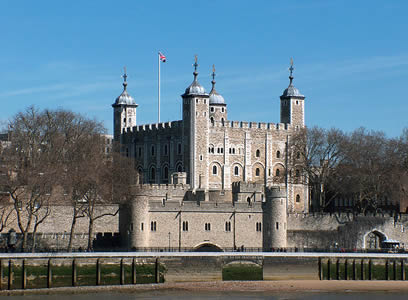 The Tower of London: not just an XTC song any more. | Here Come the NormansBut come medieval times, things started to whip up again. The Tower of London was built by William the Conqueror as a clear showing of who, for the next bit, would be boss. The Tower is well worth a visit; get there early as it can be busy. It's really a rather complex site, with the oldest bit (the White Tower) in the middle and with outer fortifications of varying ages. It's still officially a royal palace, but doesn't have much in the way of accommodations suited for a monarch--although there were royal apartments in the Tower, this was always more a military/defensive structure than a palace. It's been used as a prison, an armory, a mint...all manner of things at all sorts of times. Prisoners here included just about anybody in England who ever was anybody, and if you were really, really important, you got beheaded here, too, instead of up on Tower Hill, though nobody is thought to have ever given thanks for the privilege. The Crown Jewels, if you like waiting in exceptionally long lines, are here. |
More MedievalismAnd the Tower wasn't all that medieval London left behind. The Palace of Westminster is gone, but bits of it--Westminster Hall, and the Jewel Tower--remain. The Jewel Tower can be visited any time, but if you wnat to see Westminster Hall, you'll need to schedule yourself a tour of the Houses of Parliament. Do that ASAP as it books up solid. Westminster Abbey remains, while the medieval St. Paul's was a victim of the Great Fire of 1666 and so that church (which we'll get to below) is comparatively new. The Abbey is a nice visit, but like the Tower, is fantastically crowded at times. Kings and Queens are stacked like cordwood in tombs of various sorts, while other national heroes of sorts--from poets to politicians to scientists--are located all over the place. Be sure to ask at the desk where Elvis Presley's buried. And Pat Sajak. | 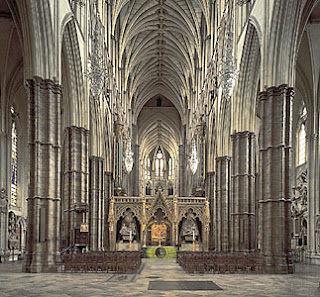 Westminster Abbey. Mind the poets. |
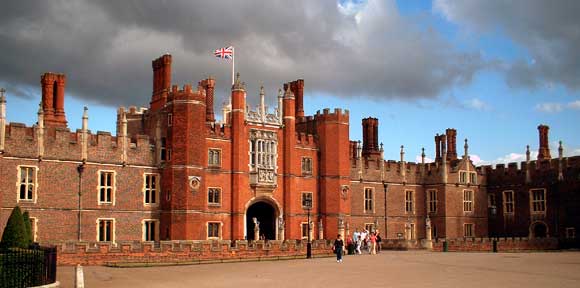 Hampton Court. Mind the heads. | Tudor London:Well, there isn't a lot of Tudor London, I'm afraid. But Hampton Court Palace is in Richmond, a short little commuter-train hop away, and interesting. Built by Cardinal Wolsey before Henry VIII cut him down a notch (figuratively), it wound up in Henry's hands, and he housed Anne Boleyn there...and eventually cut her down a notch (literally), too. This was a principal royal palace for many years, and has some nifty things--a vast and unbelievable Tudor kitchen with the largest fireplaces you've ever seen, and one of the handful of remaining "Real Tennis" courts (that's "Real" as in "Royal," not as in "Actual"). |
The Faux Elizabethan Period:Well, as noted, there's not a lot of Tudor London left, but many people do enjoy the faux-Elizabethan Globe Theatre, on the south bank of the Thames, built as a replica of the original. Lotsa Shakespeare, lotsa standing room, big lines. And the Globe isn't the only faux-Elizabethan building around. Everywhere you turn, you'll see classic-looking Tudor buildings in London, with the timber half-frame construction and the whitewashed wattle-and-daub plaster walls, and they're pretty much all fakes from much later times. Authentic buildings of this period certainly do exist all over England (heck, Lavenham, in Suffolk, is stuffed with 'em), but not so much here; too much Great Fire and too much Blitz. | 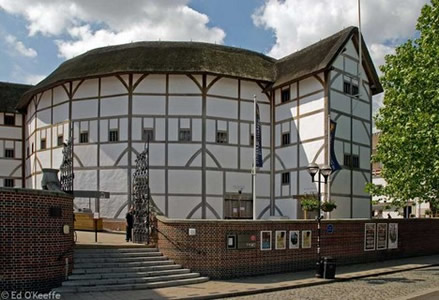 |
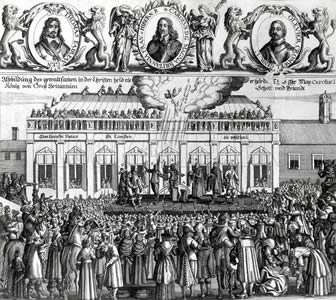 Charles I on a bad day at the office | Stand Where Charles I stood, but don't bend over:Down in Westminster, there used to be palaces galore. Westminster Palace presumably got a bit drafty (or draughty) and so Whitehall Palace was built practically next-door. Then most of Whitehall burned down, and then most of Westminster Palace burned down as well. "The third one burned down, fell over, and then sank into the swamp," as a wise man once said. Whitehall's Banqueting House remains, though, and this was the place where Charles I had the distinction of being the only King of England ever to be executed for treason which, puzzlingly, was traditionally defined as an offense against the King. But the revolutionaries who ushered in the Commonwealth years weren't very good on legal scholarship, and off the head came anyway. In defense of Cromwell, it is fair to say that anyone who ever saw Charles I thought he did need a serious haircut. |
Other things from about that period: the Royal Naval College and the Royal Observatory, in Greenwich, just a tube ride out from the center of town. Go for a good time, go for a mean time. Stand on the Prime Meridian, but be sure not to violate the Prime Directive while so doing. See the original clock which solved the problem of longitude, and the Cutty Sark, too, while you're at it. | 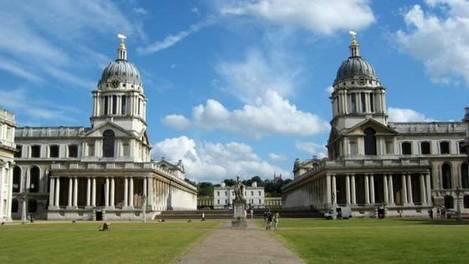 |
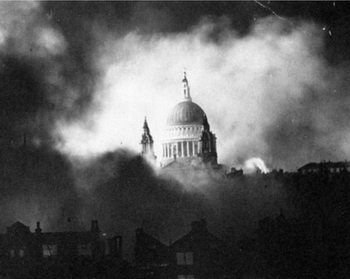 St. Paul's, somehow surviving the Blitz | During the reign of Charles II, the whole danged place burned down. Well, the City proper, anyway. This meant that the medieval St. Paul's Cathedral went up in flames, and it fell to Christopher Wren to design the new one. Unlike Westminster Abbey, which is broken up considerably inside by the need for pillars and buttresses, the new (well, 300-some years old) St. Paul's has some massive spans and the pillars and buttresses have been integrated into the building much more so as to provide a vast, open, airy feeling. The contrast between the two churches is quite interesting. Here, climb to the top (yeah, I know; suck it up; it's worth it when you get up there, plus, you get to see London's largest collection of "Mind Your Head" signs on the way up), see the City from above, then head down to the basement and pay Admiral Nelson, the great naval hero who died in victory at the battle of Trafalgar, a visit. A bit down the street, you can see Nelson's Column at Trafalgar Square; Nelson must have one bad case of vertigo by now. |
Georgie-PorgieSo, now we get around to Georgian times and there's a heck of a lot more because it didn't all burn down. There's less than there once was, unfortunately, because Hitler was not kind to the town. But somewhere in here begins Industrial Revolution England, and this is exciting stuff. Canals are dug to move goods; visit the Canal museum. The port of London becomes bigger than ever; visit the Docklands Museum to learn more. And life starts to change; things get more crowded, and this City is suddenly the economic center of the known world. | 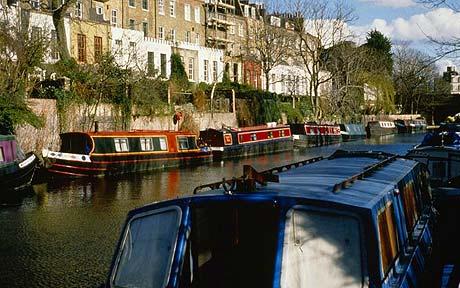 Canal routes: much more fun than root canals |
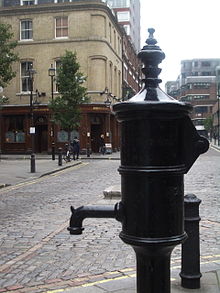 Cholera's terminus | Victoria, and her EgretsVictorian England is a blast. They get the sewers straightened out, and people stop dying of cholera; you can visit the well site in Soho where the relationship between contaminated wells and cholera was first worked out--and then ignored for a generation or so. They build great museums where the non-cholera-infected masses can go and appreciate art and science--the Victoria and Albert, if you're into the arts, and the Natural History Museum, just across the street, if sciences are more your thing. Albert dies young, giving rise to a marvelous concert venue ("now they know how many holes it takes to fill the Albert Hall..."), a strangely ornate memorial across the way, and a brand of pipe tobacco. | 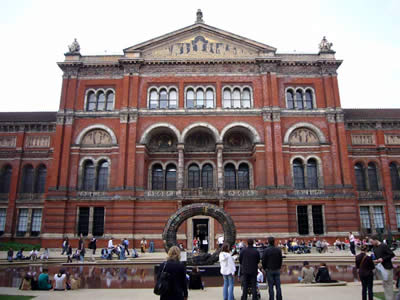 Vicky and Berty's Place |
Now, if ghoulish and terrifying medicine is your thing (or, you just want to have been someplace in London that your annoying neighbors have never visited), there's a real treat: the Old Operating Theatre Museum in Southwark. Somehow, due to bits of building getting walled-up and people forgetting what's where, an actual Victorian surgical theatre, with room for medical students to watch, learn, faint and vomit, managed to be preserved through the ages for us to see. No live demonstrations, but the guide gives a vivid talk. Smelling salts are, I'm sure, available in the accompanying Herb Garrett. | 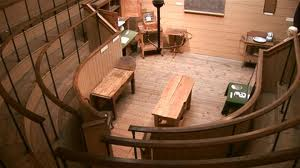 Yes, really. And really cool. |
 | And the Victorians built Tower Bridge, surely both the most beautiful and the most inadequately-sized drawbridge (for cars, anyway) in the world. If you want to know more about this iconic site, there's now a full tour through the towers and the steamworks that made it all tick. Very steampunk, only for real. |
Most Victorians, of course, didn't have it so good. The advent of the big city was also the advent of modern urban poverty, and nobody chronicled that like Charles Dickens, whose museum sits up in Bloomsbury. Also in Bloomsbury you will find the British Museum, which Victorian explorers filled with wonderful things from all over the world. See the Elgin Marbles, and the Rosetta Stone (right), among other things; there's enough stuff here to make a whole spare Egypt. In domestic treasures, see the Lewis Chessmen, the Sutton Hoo ship burial, the Vindolanda tablets...oh, heck, see it all. Bring comfy shoes for the hard floors, and plan to stay for a trillion hours as this place just goes on and on. Massive nerd-focused gift shop. Did I mention that admission to this amazing spend-a-week-just-gaping site is free? |  And nobody to sell you a yellow box |
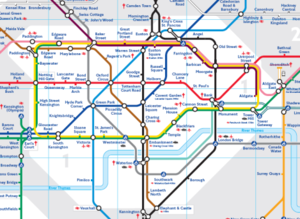 | One attraction of the city is going to be in your path whether you seek it out or not: the Tube. The London Underground is not a protest movement, though there is a good deal of moving and protesting to be had. The tunnels are remarkable, the trains are interesting (though not as charismatic as they once were), and the exhortations to "Mind the Gap" are humorous in a slightly surreal way, coming to you like the voice of Big Brother in level tones over ancient speakers. Buy an Oyster Card, and ride the darned thing all over the place; it is usually the quickest and cheapest way to get between points. |
The Twentieth CenturySo, along come our times. The twentieth century is less full of historic buildings and more full of wars and nastiness. Britain, of course, was at the center of the most dramatic and terrifying period of the twentieth century, the Second World War, and unfortunately, much of the city was completely bombed-out in the Blitz, but interesting remnants of that period remain. The oddest, and most evocative, may be the Churchill War Rooms, a set of bunkers built underground as a command center for the Prime Minister, then completely forgotten about for decades--now on display in almost as-found condition. Be sure to use the audio guide as the exhibits are not as well-labeled as you might want. If you have any interest in the war, the Blitz, Churchill--well, then this is absolutely not to be missed. | 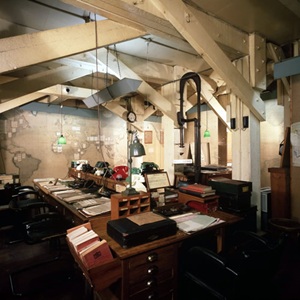 |
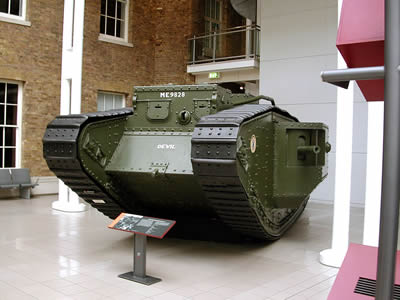 No fun to be in, less fun to be out | If the war, and wars in general, are of interest, there are also a lot of military exhibits in town. The HMS Belfast cruiser, on the Thames; the Imperial War Museum, with all manner of wild and odd things, including this lovely WWI tank (left) and some "experience"-type exhibits on both World Wars; the National Army Museum (good exhibits on the American Revolution from the British point of view); and so on. And if it all makes you a bit teary-eyed about the fellows who had to do all the fighting and dying, you can run over to Chelsea and visit the pensioners at the Royal Hospital Chelsea. |
Timeless Bits and Things:Then there are things not really associated with a particular era. The Museum of London spans all time periods of which anything is known. The ten zillion pubs are frequently, though not always, worth a visit; try The Lamb in Bloomsbury while you're on a Dickens/British Museum jaunt, or The Cheshire Cheese (yeah, it could be full of tourists) on Fleet Street. If you are dragging under-age people around, don't worry; they are almost always welcome in the pubs. Now, when you're in that pub, don't order a lager beer; most lager sold in the UK is nasty and worthless stuff. You want a pint of bitter, or ESB, or some such thing, and you want it dispensed not from a pressure-driven keg but from a hand-pumped cask. Watch them draw your beer with a long pull on that pump handle; now, that is the stuff. If the beer is fresh and the cellar is right, the beer will be cool, not cold, and the carbonation will be light. "Flat and warm," my arse. Ass. Whatever. |  The Lamb. Have a pint. |
If the Tube and those double-decker buses interest you beyond the "hey, look at that" phase, there is the London Transport Museum, located just outside Covent Garden Market (home of Eliza Doolittle of "My Fair Lady" and of the necktie strangler guy in Hitchcock's "Frenzy"). Ridiculous amounts of information abound, together with classic conveyances of every sort and explanations of just how it all came to be. "Mind the Gap" T-shirts are available to puzzle your friends.
And then there are the streets. Don't let the convenience of the Tube prevent you from just getting out and having a good walk. The stroll from the Tower to Westminster Abbey is a nice one, taking you past Fleet Street, St. Paul's, and Trafalgar Square, among other things. The walk along the south bank is a bit sketchier and more Bohemian, but also interesting.
There is entertainment, too, of course. The West End is the home of every doggoned musical in the universe, and many of what somehow come to be known as "Broadway" musicals actually start here. If you're interested in seeing a show when you're there, you should shop for tickets NOW. The most popular shows can be sold out for months.
Things to Avoid the Heck Out Of:
An unfortunate consequence of the City of London being a favorite tourist destination is that there is a decent amount of dreck to be had. Pseudo-museums like the Clink Museum, cheesy tours, and every damned souvenir imaginable with a Union Jack on it (made in China, of course), are to be avoided like the plague. If someone calls you "guv'nor," you probably should run as fast as you can in the other direction. Just remember, though, that if they call you Canadian, that's intended as a compliment. It means you haven't offended them, which makes it difficult for them to imagine that you're from the USA.
And All The Stuff I Haven't Mentioned:
Is there more? Heck, yeah. John Soane's Museum. The Freud Museum. The largest collection of Starbucks outside Seattle. Hyde Park. The Zoo. Highgate Cemetery, where Karl Marx stares across the aisle at Herbert Spencer and Douglas Adams. Hampstead Heath. 'ampstead 'eath. Camden Lock Market. Lord's Cricket Grounds. Parliament. Funkadelic. Kensington Palace. Buckingham Palace. Harrod's. And it just goes on, and on, and on, and on. What are you interested in? If it doesn't involve peace and quiet, it's here.